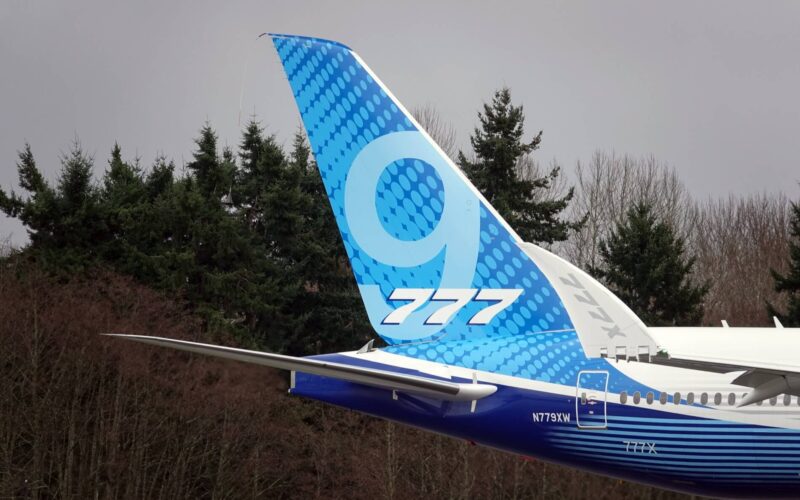Boeing’s current flagship airliner, the 747-8, will see the end of its production in 2022. In the same year, the brand-new Boeing 777X is expected to enter service, taking over the advantages and burdens that come with such a title. The king is dead, long live the king!
After taking a good look at its most successful long-haul, wide-body airliner, the 777, Boeing decided to advance the legacy design further into the 2020s and beyond. The first next generation variant of the Triple Seven series, the 777X, is the largest twin-engine jet to ever roam the skies. However, a lot of technologies for generational improvements were borrowed from the smaller 787 Dreamliner.
A pair of newly developed General Electric GE9X engines are at the heart of the Boeing 777X. With 10% improvement of the aircraft fuel burn versus 777-300ER and 5% improvement of fuel consumption versus virtually any design in the class, the GE9X increases efficiency and keeps similar range to its predecessors in defiance of increased weight. The sheer size of the engines is massive enough to be comparable to the entire fuselage diameter of the 737 series. General Electric claims that the GE9Xs will also be the quietest engines ever produced by the company.
Fuel efficiency is improved further by the configurable-length wingspan. The wingtips are retractable and extend flat just before takeoff to increase fuel economy. Extended wingspan reaches 235 feet 5 inches (71.75 meters) and is 212 feet 9 inches (64.85 meters) when folded. The main reason for the mechanical folding is to make the aircraft able to land at more airports worldwide. The FAA’s Airplane Design Group (ADG) categorization, which consists of 6 categories defined by aircraft wingspan, is directly linked to aircraft acceptance at the airports. Group 6 (214 ft – < 262 ft, 65 m – < 80 m), under which the 777X falls with its wingtips extended, is dedicated to the largest aircraft such as A380s. If assigned under this group, the aircraft becomes severely limited in terms of number of airports it can land.
By having the wingtips foldable, the wingspan is significantly reduced. Consequently, the Boeing 777X fits well within the boundaries set for the Group 5 (171 feet – < 214 feet, 52 m – < 65 m). The fifth group offers far greater selection of airports, allowing the aircraft to cover areas dedicated to regular wide-body traffic. In turn, the 777X could be stored and maintained alongside its “fixed wing” predecessors and counterparts. Most importantly, the lower group could attract more customers. Foldable wings will be an absolute novelty among operational wide-body airliners, although the idea itself has been employed by militaries since the 1930s to save space, especially in naval aviation.
Following orders through July 31,2020, 350 units of the 777Xs have been ordered by eight airlines: All Nippon Airways – 20, British Airways – 18, Cathay Pacific – 21, Emirates – 156, Etihad Airways – 25, Lufthansa (LHAB) (LHA) – 20, Qatar Airways – 60, Singapore Airlines (SIA1) (SINGY) – 20, unspecified – 10, with Emirates by far having the largest order. Although the latest developments indicate that Emirates could shift some orders to the smaller 787 Dreamliner.
The biggest competitors of the Boeing 777X are its domestic peers the 787, the 777 and the rivaling Airbus A350. In essence, competing with itself is not the worst case scenario but every swap away from the flagship 777X is an impactful financial downshift as prices start from $410 million per unit. For example, every swap from 777-9 to 787-10 is a loss of around $72 million at least.
The main rival, the Airbus A350, lacks sheer capacity offered by Boeing. Nevertheless, by having a proven service record of 5 years, the A350 automatically becomes more approachable and simply a safer choice at the moment. On paper, both aircraft look like great offerings but it will be an arduous task for Boeing to beat the A350 in all but most volumetric routes.
The 777X is scheduled to be delivered to the first customers in 2022. Thus far, three test vehicles were produced and extensively tested throughout 2020 in order for the design to be viable for the certification in 2021 by the latest. As a flagship, the 777X will undoubtedly see its fair share of customers but at the moment the future is being dimmed by COVID-19, some hesitant customers, its own peers and predecessors, and a great offering from Airbus.
Knowing that the 737 MAX crisis is still being dealt with, Boeing has a rather lengthy list of obstacles to overcome. Maintaining orders and delivering introductory vehicles in a timely manner will be paramount.

